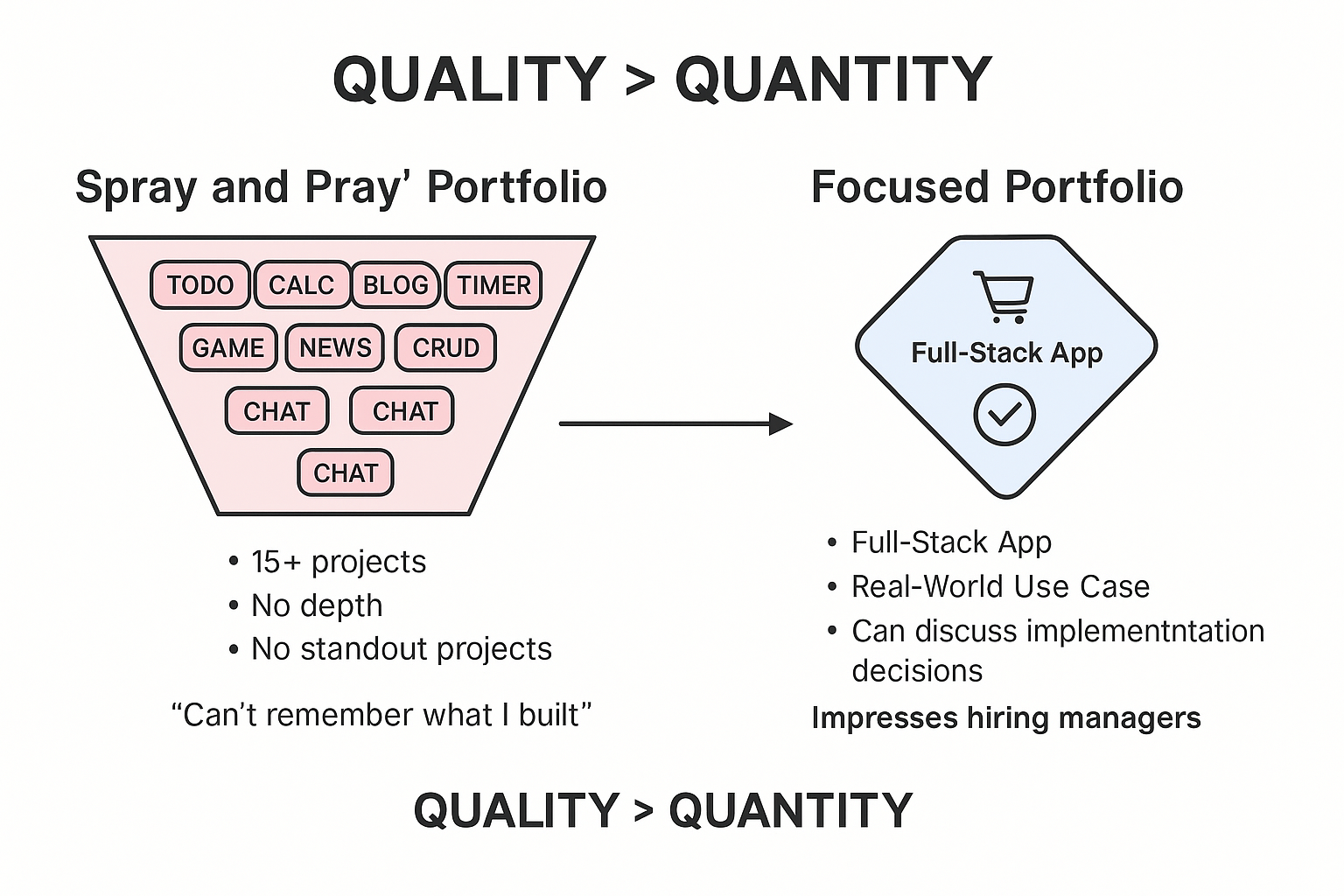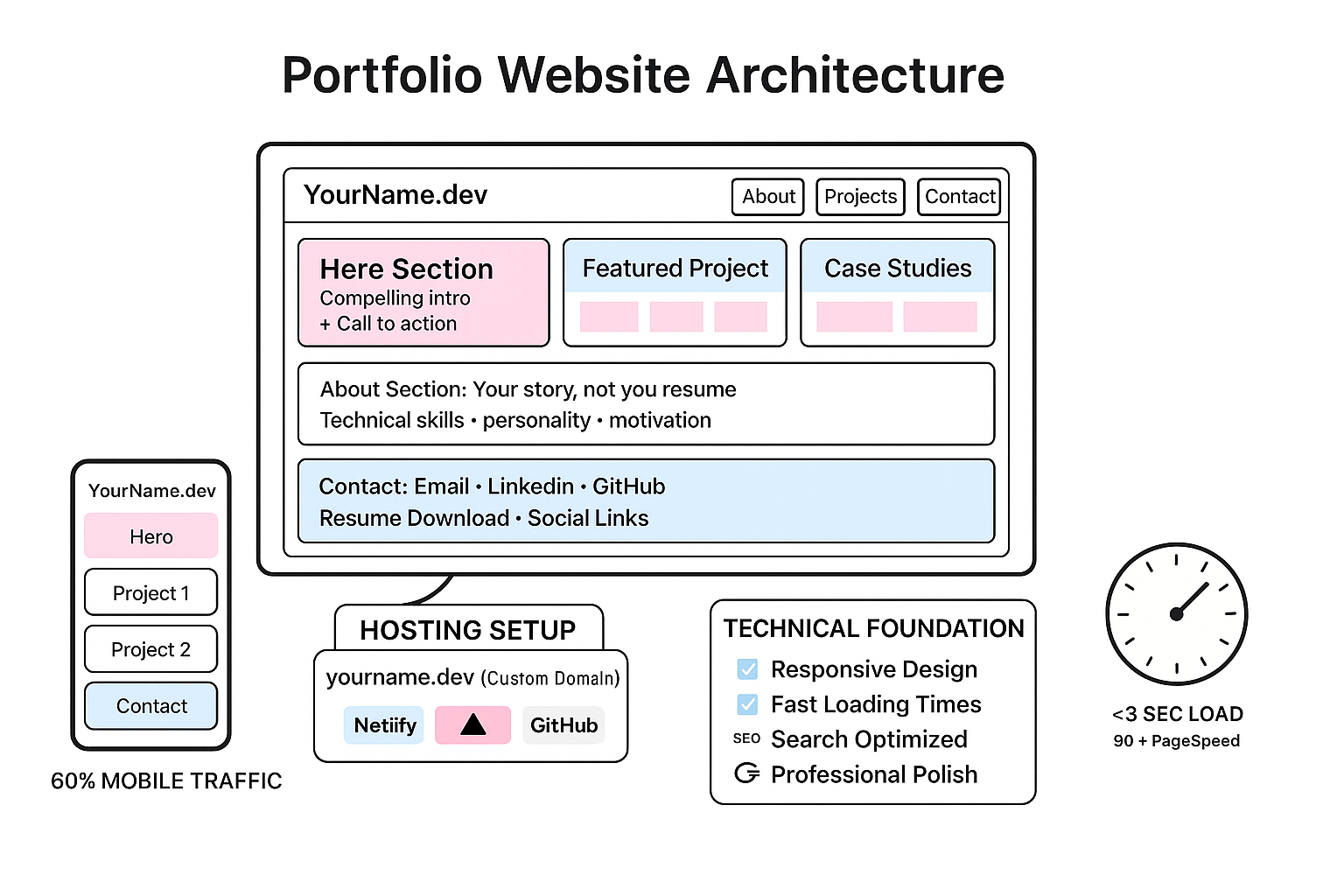How to Build a Portfolio for Software Engineering

How to Build a Portfolio for Software Engineering: Make Your Work Impossible to Ignore
You’d be shocked how many software engineers have portfolios with broken links, lorem ipsum, or zero code. One even featured a photo of their cat as the homepage.
If you’re serious about getting hired, you need to know how to build a portfolio for software engineering that actually proves you can think, build, and deliver. Let’s make yours unforgettable, for the right reasons.
The Software Engineering Portfolio That Lands $200K+ Offers
I've seen countless engineers miss out on opportunities simply because they didn't have a portfolio, or worse, they had one that was doing more harm than good.
Here's the thing: In today's market, where software engineering demand is set to increase by 25% between 2021 and 2031, having a portfolio isn't optional anymore. It's the difference between getting that interview and getting lost in the pile of applications.
I'm going to walk you through exactly how to build a portfolio that hiring managers actually want to see. No fluff, just the playbook that's worked for me and dozens of engineers I've mentored.
Planning Your Portfolio Strategy
Before you write a single line of code, you need to think like the person who's going to hire you. I've sat on both sides of the hiring table, and I can tell you exactly what works.
Define your target audience (hiring managers, clients, collaborators)
First things first. Who are you building this for? Are you trying to land a FAANG job? Looking for startup opportunities? Want to freelance? Each audience cares about different things.
For hiring managers at big tech, they want to see clean code, scalable solutions, and that you can handle complexity. For startup founders, they care more about speed, scrappiness, and can you ship features that users actually want. Freelance clients want to see that you can solve their specific business problems.
I learned this the hard way when I first built my portfolio targeting everyone and ended up appealing to no one. Pick one primary audience and optimize for them.
Still, in engineering - you should be learning by doing. So in the process, you naturally put together a portfolio. And any portfolio is better than none.
Identify your unique value proposition
What makes you different from the other hundred engineers applying for the same role? Maybe you're the person who can bridge frontend and backend seamlessly. Maybe you have domain expertise in fintech because of your previous career. Figure out your angle.
In my case, I positioned myself as the engineer who could translate complex technical concepts into business value, something I picked up from working closely with product teams. That became my differentiator.
Set clear portfolio goals
Be specific about what you want your portfolio to achieve. Is it to:
- Land 3 technical interviews per month?
- Get contacted by recruiters weekly?
- Demonstrate specific skills for a particular role?
Having clear goals helps you measure success and iterate. I track metrics like portfolio views, contact form submissions, and how often my projects get referenced in interviews.
Selecting Your Best Projects
This is where most engineers screw up. They think more is better. Wrong.

Quality over quantity principle
Three exceptional projects beat ten mediocre ones every single time. I've seen portfolios with 15+ projects where I couldn't find a single one worth discussing in an interview.
Here's my rule: If you wouldn't be excited to talk about a project for 30 minutes straight, don't include it.
Showcasing diverse technical skills
Your projects should tell a story about your technical range. I recommend this mix:
- One full-stack application (shows you can handle end-to-end development)
- One system design heavy project (demonstrates scalability thinking)
- One that solves a real problem (proves business acumen)
Including both personal and professional projects
Mix it up. Professional projects show you can work in a team and ship real products. Personal projects show initiative and passion. The best portfolios have both.
Pro tip: For professional projects you can't share code for, create a similar project on your own time that demonstrates the same skills.
Demonstrating problem-solving abilities
Don't just show what you built, show your thinking process. I always include a section on challenges I faced and how I solved them. Hiring managers eat this stuff up because it shows how you'll handle problems at their company.
Building Your Portfolio Website

Choosing between custom-built vs. template solutions.
Here's where your ego might get in the way. Building everything from scratch is tempting, but it's often a mistake.
If you're a frontend engineer, yes, build it custom to show off your skills. If you're a backend engineer or systems engineer, use a template and focus your energy on your project descriptions and code quality.
I've seen brilliant backend engineers spend months perfecting CSS animations while their actual projects sat half-documented. Don't be that person.
Setting up hosting and a domain
Get a custom domain. yourname.dev or yourname.com, doesn't matter which, just don't use yourname.github.io. It's a small detail that makes a big difference in perceived professionalism.
For hosting, I recommend:
- Netlify for frontend/static sites
- Vercel, if you're using React/Next.js
- GitHub Pages if you're on a tight budget
Implementing responsive design
Your portfolio will be viewed on phones. I can't stress this enough. 60% of traffic is mobile these days, and if your site looks broken on mobile, you've already lost.
Test on actual devices, not just browser dev tools. I learned this when a recruiter told me they tried to check my portfolio during their commute and gave up because it was unusable on mobile.
Ensuring fast loading times
Page speed matters more than fancy animations. If your site takes more than 3 seconds to load, people will bounce. Optimize images, minimize JavaScript, and use a CDN.
Google's PageSpeed Insights is your friend here. Aim for scores above 90.
Content Creation and Organization
This is where you separate yourself from the pack.
Writing compelling about section
Tell your story, not your resume. People can read your resume; use this space to show personality and motivation.
Instead of: "I am a software engineer with 3 years of experience in React and Node.js"
Try: "I fell into programming trying to automate my previous job in marketing. What started as a way to save time became an obsession with building software that actually makes people's lives easier."
Creating detailed project case studies
This is the most important part of your portfolio. Each project should follow this structure:
- Problem: What were you trying to solve?
- Approach: How did you solve it?
- Technical details: What technologies and why?
- Challenges: What was hard and how did you overcome it?
- Results: What was the impact?
- Live demo & code: Working links, always
I spend 80% of my portfolio time on project descriptions. The code speaks for itself, but the story around it is what gets you hired.
Organizing navigation and site structure
Keep it simple:
- Home/About
- Projects
- Contact
- Resume (downloadable PDF)
That's it. Don't overthink navigation. People should be able to find everything in two clicks max.
Adding contact information and social links
Make it stupidly easy to contact you. Email, LinkedIn, GitHub, and a contact form if you're feeling fancy.
Pro tip: Use a professional email address. [email protected] beats [email protected] every time.
Invest the time to build a solid portfolio, but don't obsess over making it perfect. Your goal is "good enough to impress" and "finished is better than perfect."
Get Your Portfolio Found: The SEO Playbook That Actually Works
Having an amazing portfolio that nobody can find is like having the best resume sitting in a drawer. You need discoverability.
I learned this when my first portfolio got zero organic traffic for six months. Meanwhile, my friend's mediocre portfolio was getting 2-3 recruiter contacts per week because he understood search engine optimization.
The good news? Portfolio SEO isn't complicated. You just need a few key strategies that actually move the needle.

Using schema markup, meta tags, and SEO-friendly URLs
Let's start with the technical stuff that takes 30 minutes but pays dividends forever.
Schema markup tells search engines exactly what your content is about. For portfolios, this is gold:
<script type="application/ld+json">
{
"@context": "https://schema.org",
"@type": "Person",
"name": "Your Name",
"jobTitle": "Software Engineer"
}
</script>
Meta tags are your elevator pitch to search engines.
Instead of: "John's Portfolio" Try: "John Doe - Full Stack Engineer | React, Node.js Developer Portfolio"
SEO-friendly URLs:
- Good: yourname.com/projects/ecommerce-platform
- Bad: yourname.com/project1.html
Pro tip: Include target keywords naturally in your URL structure.
Blogging on your site for long-tail search visibility
This is where the magic happens. Writing blog posts is the single most effective way to get found by recruiters.
When someone searches "How to optimize database queries in Node.js" and finds your post, they immediately see you as an expert. If they're hiring, guess who comes to mind?
I've gotten three job offers directly from people who found my blog posts first.
What should you write about?
Technical tutorials from real problems:
- "How I reduced API response time by 60% using Redis"
- "Building real-time notifications with WebSockets"
Project deep-dives:
- "Behind the scenes: Building a scalable chat app"
- "The architecture decisions that handled Black Friday traffic"
The key is being specific and sharing actual insights, not generic tutorials.
Publish one post per month, minimum. Consistency beats perfection, Google rewards regular quality content.
How to get GitHub projects discovered (stars, forks, good READMEs)
Your GitHub profile is often the first technical impression. Most engineers treat it like a code dump. Big mistake.
Project READMEs that convert:
Every README needs:
- Clear description (what it does, why it exists)
- Live demo link (always, no exceptions)
- Tech stack with reasoning
- Screenshots showing the app in action
- "What I learned" section (hiring managers love a growth mindset)
Getting stars organically:
- Share in relevant communities (Reddit, Dev.to, Twitter)
- Contribute to open source strategically
- Document solutions publicly
GitHub optimization:
- Pin your best repositories
- Use proper tags and topics
- Keep the contribution graph consistent
- Professional commit messages
Most engineers treat discoverability as an afterthought. That's your competitive advantage. Spend a weekend implementing these strategies and see results within weeks.
Let Your Portfolio Be the Reason You Get the Callback
Your portfolio is more than a personal website, it’s a signal that you know how to build, think, and deliver. Show off projects that solve real problems. Write case studies that highlight your process.
Make it easy to navigate, fast to load, and impossible to forget. When done right, your portfolio won’t just get viewed; it’ll get callbacks, interviews, and offers.
What makes a portfolio memorable isn’t pixel-perfect design. It’s proof that you can build and solve problems. Want more real talk that actually helps? Subscribe below, and I’ll keep it coming.




%2C%20Color%3DOriginal.png)



